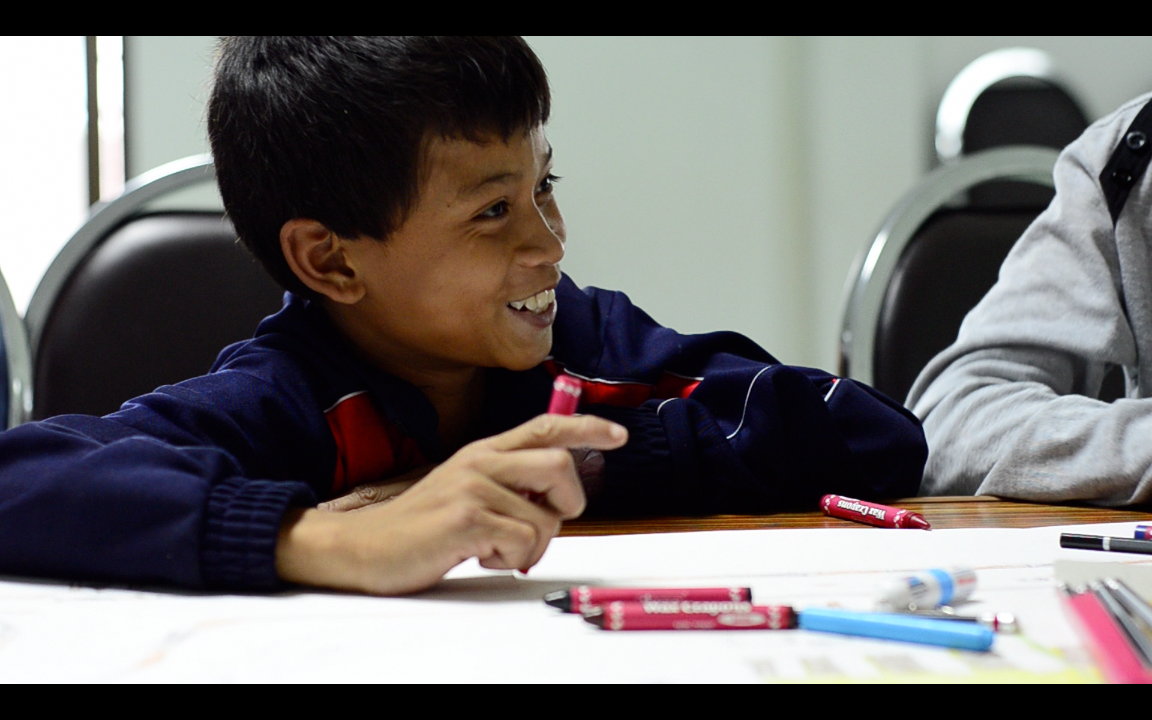“And I want a blackboard!” Reflections on WVLaos’ first Children’s Council
by Amelia Merrick
World Vision Lao PDR National Director
January 2013
At 13, he is small and feisty. Somsavath has bright black eyes, a wide toothy smile and weathered skin. Commanding an unusual sense of authority for a Lao village boy, Somsavath leads me through hissparse village in southern Lao PDR.
We start at his school. It’s not in session today so we peer through the slatted windows. Somsavath points out the bare walls. Unlike the schools I might see in Vientiane, the nation’s capital, there are no maps on the wall, no handmade cut outs or origami birds framing the blackboard. In fact, I don’t even see a blackboard.
Somsavath leads me round to the dusty field at the front of the school and introduces me to a throng of children. They are small but they are timid, unsure of the foreign woman in their presence. The little girls are in black singhs- the long narrow skirt with shiny threaded border that are the Lao national dress. Somsavath leans in to the group of children and, in a surprisingly loud voice, introduces me.
I am in Somsavath’s village to get a better understanding why children are dropping out before Grade 5, and to see if there is something World Vision can do about it.
As I ask the children questions, Somsavath urges them to respond. For the children who do not speak the Lao language, but an ethnic dialect, Somsavath translates.
We learn that many children drop out because there is no school offering classes beyond Grade 5 nearby. Many girls quit school to help their family. Many marry before they’re 18. For boys, many have to work in the fields to make sure there is enough to eat.In a lot of the cases, parents don't understand the importance of education.
And yet, it’s clear Somsavath does. He’s passionate about it. He wants children to remain in school longer. As the day continues, he leads children in his village in games and activities. He continues to encourage others to talk education.
Today, I have met my first young leader.
~~~~~~~~~
September 2013
Nine months later,Somsavathgreets me with the same toothy smile, the fiery eyes. This time, we’re hundreds of kilometres from his village. We’re at World Vision’s National Office in Vientiane. Somsavathis here to deliver a message, along with 11 other young leaders from our 599 villages.
“I want a blackboard for my school!” he says spiritedly.
Somsavath and the 11 other young leaders are representing the hundreds of other children in their villages. They are part of the first World Vision Lao Children’s Council and they are dreaming about change for the future.
The Lao government has an ambitious goal to emerge from the “Least Developed Countries” status by 2020, just at the time when Somsavath and the 11 otherteenagers emerge into adulthood. Most of them will turn 20 in 2020.
We asked the teenagers what they expect by 2020 -- and what World Vision must do to help their villages get there.
With absolute conviction Somsavath stomps his foot and tells us: “I would like to have a table, teacher and blackboard in my school. I would like to have a health centre and nurse in the health centre. I want latrines.”
Other children, like 15-year-old Pheangkham from Phoukoun district, have another vision for their community. She passionately shares, “I want to have a market and a health care centre in our village. We still lack education and a health centre.”
Twelve-year-old Laxun from Xebengfai district shares: “[Our] school is very old, I took a photo of it and brought it here to show people. Next year I will study in the first year of the secondary school and it’s in another village. I’ll walk. The children who are my age, they only complete primary school and they drop out. Some people are studying in Grade 2 but they are big already, and they feel shy and then, after a while, they drop out.”
In Laos, three out of every four children lack at least one basic need – whether it is shelter, clean water or education.
Across the country, only 61% of children complete grade five and it is far more difficult for girls.
More than 40% of children are stunted and child deaths are not uncommon.
This year we grieve that 50 of World Vision’s 45,000 sponsored children died, many of them from preventable diseases. Four children committed suicide.
For many children, hope is fleeting and it is rare they asked for their ideas for change.
That is why I pray that WVL’s first children’s day marks a milestone in our history.
We started our work in Laos 45 years ago and my prayer is that the voice of children will be an influencing factor for the next 45 years. One of the forefathers of child development work in Laos said, “To shape the future youth need to be part of the planning of the present…”
And it sounds to me that these 12 youth are keen to do just that.
Pheangkhamhas a glimmer in her eye when she says, “When I grow up, I want to be the leader of World Vision Lao. But I want to be based in Luang Prabang.”
Maybe we should consider relocation?
